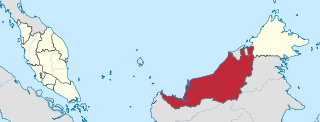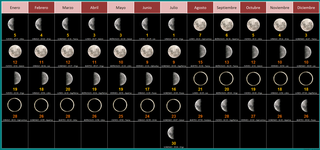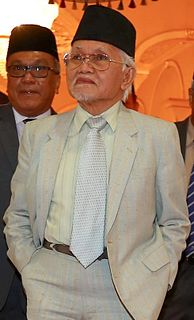
Kota Samarahan is the administrative seat of the Samarahan District in Samarahan Division, Sarawak, Malaysia. It is located about 30 kilometers from Kuching. The district population was 157,792. Kota Samarahan is the main education hub for Sarawak State and officially known as "Town of Knowledge". The District Officer of this city is Datuk Patinggi Puan Hajah Affidatul. On January 11, 2017, Chief Minister Adenan Satem died in Sarawak Heart Hospital in this city.
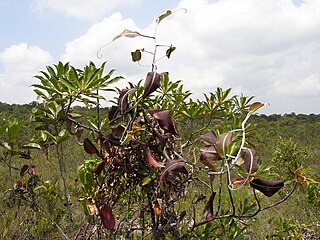
Bako National Park is a national park in Kuching Division, Sarawak, Malaysia. Established in 1957, it is the oldest national park in Sarawak. It covers an area of 27.27 square kilometres (10.53 sq mi) at the tip of the Muara Tebas peninsula at the mouth of the Bako and Kuching Rivers. It is approximately 40 kilometres (25 mi) by road from Kuching. Millions of years of erosion of the sandstone have created a coastline of steep cliffs, rocky headlands and stretches of white, sandy bays. Wave erosion at the base of the cliffs has carved many of the rocky headlands into fantastically shaped sea arches and seastacks with colored patterns formed by iron deposition.The most famous of them is shaped like a cobra's head which can be spotted on a boat ride from the headquarters or one of the beaches. Some of these rock formations can be seen on entry to the Teluk Assam Beach, which fronts the park. The park can only be reached by a 20-minute boat ride from the village of Kampung Bako. It is often visited as a day-trip from Kuching, though accommodations are available.

Malaysian Federal Roads System, is the main national road network in Malaysia. All Federal Roads in Malaysia are under the purview of the Ministry of Works (MOW). According to the Ministerial Functions Act 1969, the MOW is responsible to plan, build and maintain all Federal Roads gazetted under the Federal Roads Act 1959. However, most of the Federal roads' projects were built and maintained by the Malaysian Public Works Department (JKR), which is also one of the implementing agencies under the MOW.
The Federal Route 1 is the first federal road in Malaysia, and also the oldest federal road in Malaysia, as well as among the nation's earliest public roadways ever constructed. The Federal Route 1 was the backbone of the road system in the western states of Peninsular Malaysia before being supplanted by the North–South Expressway.
East–West Highway or also known as Gerik–Jeli Highway, Kulim–Baling Highway and Titi Karangan–Gerik Highway, Federal Route 4, Asian Highway Route 140 is the 215 kilometres (134 mi) federal highway constructed by the Malaysian Public Works Department (JKR) to shorten the journey from Kota Bharu, Kelantan to northwestern towns and cities of Malaysia such as Alor Star, Kedah and Penang. The highway connects Gerik, Perak in the west to Jeli, Kelantan in the east, before being extended further to Lunas, Kedah.
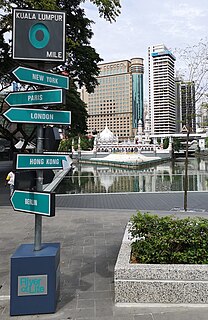
Klang River is a river which flows through Kuala Lumpur and Selangor in Malaysia and eventually flows into the Straits of Malacca. It is approximately 120 km (75 mi) in length and drains a basin of about 1,288 km2 (497 sq mi). Klang River has 11 major tributaries.
Federal Route 55 or Jalan Kuala Kubu Bharu–Teranum–Raub is a 62-km federal road connecting the states of Selangor and Pahang in Malaysia. It is the first federal road ever being constructed in Pahang. The road connects Kuala Kubu Bharu, Selangor to Teranum near Raub in Pahang. It is the main access route to Fraser's Hill.
Senai–Desaru Expressway, SDE, is an expressway in Johor, Malaysia. It connects Senai in western Johor to Desaru in eastern Johor. Measuring a total length of 77 km (48 mi), it is the third east–west-oriented expressway in the Iskandar Malaysia area after the Pasir Gudang Highway and the Pontian–Johor Bahru Link of the Second Link Expressway. With a new crossing over the Johor River, when opened on June 10, 2011, the expressway shortened travel time from Senai to Desaru from 2.5 hours to one hour.

Petra Jaya is a suburb of Kuching, Sarawak, Malaysia. This suburb was named after sixth Yang di-Pertuan Agong, Tuanku Yahya Petra of Kelantan (1975-1979).

Floods in Malaysia are regular natural disasters in Malaysia which happen nearly every year during the monsoon season.

Bangar is a mukim in the Temburong District of Brunei. It is located in the north-west of the Temburong District bordering Mukim Labu to the north, Mukim Batu Apoi to the east, Mukim Amo to the south-east, Mukim Bokok to the south-west and Limbang, Sarawak (Malaysia) to the west and north. Mukim Bangar has one island within its vicinity which is Pulau Kibi. Bangar has a total area of 113 square kilometres (44 sq mi); as 2016, it had a total population of 2,696.

Tebakang is a village in the Serian division of Sarawak, Malaysia, between Serian and Tebedu. It is about 15 minutes drive from Serian Town. Tebakang lies approximately 56.9 kilometres (35 mi) south-south-east of the state capital Kuching.

Tondong is a settlement on the Sarawak Kanan river in the Bau division of Sarawak, Malaysia. It lies approximately 25.2 kilometres (16 mi) southwest of the state capital Kuching.

The Malaysian Expressway System is a network of national controlled-access expressways in Malaysia that forms the primary backbone network of Malaysian national highways. The network begins with the North–South Expressway (NSE), and is being substantially developed. Malaysian expressways are built by private companies under the supervision of the government highway authority, Malaysian Highway Authority.
High intensity rainfall since 17 January 2015 caused major flooding across several parts of Sarawak and Sabah. Around 13,878 people had been evacuated with one teenage girl became the only casualty.

The Kampung Selamat station is a rapid transit station serving the areas of Kampung Selamat and Kampung Baru Sungai Buloh in Sungai Buloh, Selangor, Malaysia. The station is one of the stations on the MRT Sungai Buloh-Kajang Line and was opened on 16 December 2016 under Phase One operations of the line.

Sungai Jernih MRT station is an elevated rapid transit station on the Sungai Buloh-Kajang Line, located in the northern precincts of downtown Kajang, Selangor, Malaysia. It was opened on 17 July 2017, along with 19 adjoining stations as part of Phase 2 of the system.
The following is an alphabetical list of articles related to Selangor.

